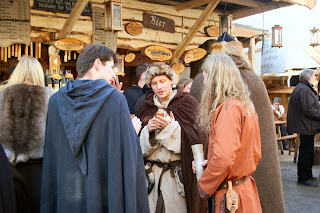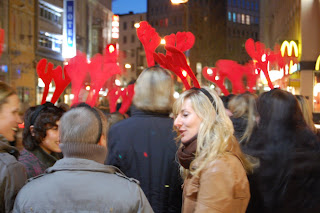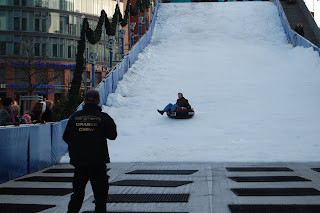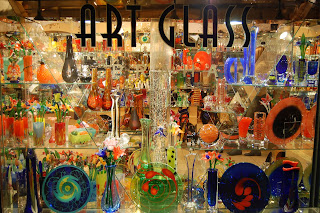(2008-09) This was a Christmas-to-New Years trip that was conceived during the heat of a Florida July. We flew into Amsterdam, rented a car and headed for Germany. First stop was the Hanseatic city of BREMEN.
The sun was out, so we enjoyed our walk into town looking at the big houses on one side and the River Weser on the other. We passed the cultural complex situated on the edge of a park that was once the moat around the city walls and then came to The Schnoor. Schnoorviertel is the Old Town; where the oldest buildings date from the 15th century, and most are 17th and 18th.
Girl with a Wreath of Flowers, 1902-03
The House of Atlantis was a Hilton hotel in the Böttcherstrasse and home of The Sky Room or Himmelssaal. The attraction here was the blue glass ceiling, as well as the outstanding design and decor.
Another outstanding Christmas Market was going at the Schlachte, the old harbor, turned upscale riverside shopping district. For the holiday it was a medieval shopping mall with stalls offering candy, candles, and more from the olden days. We heard a most unusual group of Mongolian musicians. Click here for video.
We then crossed a bridge to an island in the middle of the river and home to the Neues Museum Weserburg, which was the largest museum of contemporary art in Germany. One of the featured displays in this reclaimed coffee factory was of large photos of scantily clad women by Helmut Newton. There was a display in the “attic” consisting of different sizes of speakers. They had no sound. Appropriately, admission included an espresso at the end of the visit.
We walked all the way across the city in search of the Übersee Museum. While this was the Bremen city museum, there were often exhibitions of Art. They had a display about the American West featuring a portrait of Sitting Bull when we were there. The museum looked out onto Bahnhofplatz, where we found another Christmas market in front of the fine old train station.
 |
| Liegende Quellnymphe by Lucas Cranach the Elder |
So ended our sojourn in Bremen. I have to admit, we did not try a local delicacy called Rollos (a cross between burrito and lahmacun (turkish pizza) or the fish cakes with green sauce, as it appears all the fish cakes we saw were deep fried to death. Though we did enjoy some herring, the emblematic fish of the Hanseatic League. Click here for more photos from Bremen:
It was a short drive to HAMBURG for our next adventures. Upon arrival we bought a Hamburg Pass, which included unlimited transport for three days, plus discounts. We used our first discount that evening at the Kunsthalle und Gallerie der Gegenwart which was right next to the train station.
The whole spectrum of periods and styles - lots of German painters, a few Cranachs, lots of religious, German Expressionists; from 13th century to contemporary, featuring work by Richard Serra, Francis Bacon and others. I liked the mosquitoes over the staircase, and there was a good painting by Paula Robeson.
Then we, of course, went to the Christmas market across the street, along the Kirschenalle. Up one lane and down another. I think it was actually more than one market pushed together. And though it was Sunday night, the atmosphere was as lively as Bremen, with fewer families. We saw some good Cossak singers serenading the crowds. Click here for video.
On tv that night we recognized some animated art with cartoon called “Bernard die Eisbarren” and then “Bernd das Brot.” Both good. Bernie the Polarbear goes from almost idiotic joyful happiness to being an angry growling monster. And how can you resist an adventurous loaf of bread? We never saw them again on our trip.
Since the sun made an early exit as we neared Christmas in this northerly clime, we took the U-Bahn to the Rathaus to check out the Christmas markets there as well as look at the decorations along the inner harbor. If you were not aware, there are lots of canals in Hamburg, many beginning at this basin. This was where the high end shops and hotels were found. Click here for video of accordion band.
Walked a few streets over to find the Reeperbahn, Hamburg’s “red light district.” Unlike Amsterdam, there were no prostitutes displayed in the store windows, just a bunch of toy stores, peep shows, and clubs. We did find a sidewalk sculpture commemorating the Beatles debut in Hamburg in one of those clubs.
Again, it was not a long drive to BERLIN, and after finding our hotel, we hopped on a tram and began our explorations at the Alexanderplatz and its Christmas market. They are called Wienacht markets, here, and we saw more Cossak singers. Since we were not going to be taking on any museums that day, we saw the sights, like Unter den Linden, the magnificent boulevard with the center filled with a double row of Linden trees which runs from Museum Island to the Brandenberger Tor.
One in a series of city gates, Brandenberg Gate was built from 1788 to 1791 and after restoration, was one of the most recognizable landmarks in the World. One short block from there, along the eastern edge of the Tierpark, we found the Holocaust Memorial.
Christmas Day on Museumsinsel - Museum Island - which was between Alexanderplatz and the Brandenberg Gate. There was lots of construction going on when we were there and we had some difficulty figuring out which building contained which collection and which was open.
Although the first exhibition hall on this part of the island in the River Spree was erected in 1797, and the design for the Altes Museum was completed in 1822 by Karl Friedrich Schinkel (built in 1830), it was in 1841 that Kaiser Wilhem IV dedicated the area to Art and Science. The Altes houses the Classical Antiquities collection, displaying some of its vast Greek and Roman holdings.
We went into the Altes Nationalgalerie, reopened in 2001, home of 19th Century Art; spanning from Classicism through Romanticism and Impressionism. The museum came into being when banker J.H.W. Wagener bequeathed his art collection in 1861. The building was completed in 1876, between the French Revolution and WWI, between Classicism and Secessionists, all with a heavy German slant.
At the tip of Museum Island was the Bode Museum (1904), which contained the Classical sculpture collection and Numismatic collection. The Egyptian Museum and Museum of Prehistory and Early History were housed in the Neues Museum, which reopened in 2009. The collection was considered one of the best in Europe, with a famous bust of Nefertiti.
There were two shows going on at the time: Jeff Koons, of the mylar water balloon animals, and Paul Klee.
Boxers by Keith Haring
Also in the Kulturforum was the Gemäldegalerie, which focused on medieval to 18th century Art. Lots of Cranachs, and wall after wall of religious Art. Probably the most ever. An uncountable number of Marys. As Marie said, “a great place for Christmas.” There were also Rembrandts, Titian, Fra Angelica, Breugel (and Cranach’s Breugel-like paintings). There were paintings by Cranach Jr., a Vermeer, several Bellini that M liked, and a couple of women artists. Finally, in the very last room of the entire museum, I found a couple by Botticelli. The museum was quite large and had nice molded wood benches in various nooks for resting.
Next stop was the Sony Center near Potsdammerplatz. This was a large semi-covered space surrounded by glass buildings. Giant Lego characters welcomed us to the Christmas market. We found a small hut inside with inside seating (because it was still cold in the Sony Center) and got Glühwein and a bowl of soup. The lights were fun.
Day after Christmas we visited Nikolasplatz, considered the old part of Berlin. We went right past the Christmas market in the Schlosspark in front of the Rathaus. In the center of the park-turned-Wienacht market was a monumental fountain featuring Neptune by R. Begas, surrounded by a donut shaped skating surface for the season. Nice carousels as well. Behind the Rathaus was Nikolas Viertel, supposed to be Medieval, but didn’t feel like it, except for the Nikolaskirche. In a small churchyard was a column with a caged bear on top and an over-sized sculpture of a woman. The church is from about 1230.
Crowds were already pouring in when we got there, so we headed straight for the polar bear enclosures. First we found the habitat for the famous Knute (pronounced with a hard K), but he was curled up in a hole sleeping. So we explored. The habitats seem to be pretty nice, for what they were, and they had some ridiculous number of species living there. Interesting buildings, some with thatched roofs, lots of grass and vegetation, and the best playground.
 |
| Knute |
Arctic Bear by Marie Hammer
It was a short walk to Breitscheidplatz and Kaiser Wilhelm Church – Gedächtniskirche. Consecrated in 1895, it was built by Kaiser Wilhelm II in honor of his grandfather. The church was bombed out during the war and kept as a ruin for a reminder and, as I understand it, an expression of culpability. Next to it was a chapel with blue glass walls and a much too big and gory gold crucifix. Right outside was a Christmas market which we dutifully inspected and ate at.
From there we took the S-bahn to Charlottenburg. Actually we went to Sophie-Charlotte-Platz and walked down to Charlottenburg, where the Schloss was. We walked the length of Schlosstrasse where at the end were two museums: the Bröhan Museum (nouveau and deco design items) and Sammlung Berggruen, a formerly private collection with a great variety.
We skipped the first. Heinz Berggruen’s collection offered works of classic modern Art (early 20th century), with special emphasis on Picasso, Klee, Giacometti and Matisse. There were three floors with a large spiral staircase in the center.
Giacometti sculpture with Sammlung Berggruen's elegant staircase
Across the street was Schloss Charlottenburg (ornate palace built in 1695) which served as temporary home to state collections during renovations at other museums. And in front of it was a Christmas market. We could tell right away that this was a bit more upscale than most with items not yet seen at others. There were also brass players playing music throughout the site, and they weren’t asking for tips.
The Oberbaumbrücke was directly on the former east-west border, and during the existence of the Berlin Wall, it served as a pedestrian-only border crossing point. Along the West side of the river was the longest surviving segment of the Wall. We went back later to take pictures.
We changed trains at Nollendorfplatz for the U4, which had just two of the small yellow cars and the stations looked even older, more funky. We were underground until we pulled into the enclosed Rathaus Schoenburg station. When we stepped out of the train, the first thing we saw, through large mullioned windows was a schloss with gardens. After the short train left the station, directly back into the tunnel, we could see that the other side of the station also had large windows, but these faced a small pond with an even smaller reed marsh and some ducks. Beyond this was a large park.
We took buses north into the Tierpark and Grosser Stern and the tall column at the center of the park called Siegessäule with the Golden Else on top. A Bismarck memorial faced the column.
Built in 1908, Friedrichstraßenpassage originally was an early shopping mall, it received only minimal damage from bombing, yet demolition began in 1980. The final sections were slated to come down in April of 1990, but just two months before, the Künstlerinitiative Tacheles occupied the building. They tried to prevent the demolition through discussions and to make a long story short, a last-minute injunction was issued. "Tacheles" is a Yiddish word for "plain, honest, straightforward talk," as this was in the Jewish quarter. Originally it served as living and working place for artists from around the world. The walls were painted bright colors and sculptures went up in the courtyards. A very inhomogeneous group, as I understand it, moved in.
It was a graffiti-covered building now and we walked up a few flights of stairs without finding anything resembling Art, though by the front door someone was selling t-shirts and stuff. Went out back to what was euphemistically referred to as a “sculpture garden.” While there were a few pieces one could call sculpture, you could never refer to the trash-filled mud hole as a garden. The lease was up in 2008 and the future still unknown.
We headed south again cutting across the tip of Museum Island, the Bode Museum, and a woman playing an accordion.
On our way to out of town, we revisited the Oberbaumbrücke. From the bridge we could see Jonathon Borosky’s Molecule Man. The 100-foot high, aluminum sculpture was installed in the Spree and can be seen from far up and down river.
It was just a couple of hours to DRESDEN, the legendary fairytale city that was firebombed at the end of WWII. We parked on the south side of the Elbe and quickly found ourselves wandering among the old Baroque edifices from when Dresden was the capitol of Saxony. Well, at least the reconstructed buildings. The bombing in February of 1945 was quite thorough.
We started by walking around on top of the Zwinger. Built 1710-28, originally designed as an orangery and a setting for court festivities, it was later used for exhibitions. The most perfect example of Late Baroque architecture in Germany. Construction of the Semper Gallery ran from 1847 to 1855. Click here for video.
For fans of the famous European pruned trees, in a couple of places there were groves of trees with their branches intermingled. This must be an Art.
While we had some sunshine, we walked across the Augustusbrucke to the other side of the Elbe. More modern structures with the exception of the gold statue of Augustus the Strong. The days were very short and we were to be in Praha that night.
We got off at Karlův most (Charles Bridge) and walked across the Vitava River. Begun in 1357 when Charles IV was in charge, it was finished in the beginning of the 15th century connecting the Old Town and Prague Castle. There were artists hawking their wares on the bridge, a local tradition. Marie bought a piece of wire wrapped stone jewelry and we watched the tourists rub a statue and pose for pictures.
Four statues flanked the clock representing 15th-century Prague's four biggest worries: invasion (the Turk), death (skeleton), greed (a moneylender), and vanity (enjoying the mirror). At the top of the hour, 1) death tipped his hourglass and pulled the chord ringing the bell, 2) the windows opened and the twelve apostles paraded by acknowledging the onlookers, 3) the rooster crowed, and 4) the hour was rung. Click here for video.
From there it was a nice walk down Parizska and the fine storefronts and past the old synagogue and graveyard. But it soon got too cold for strolling.
I know we haven’t seen a lot of traditional Art yet on this visit. But, as I’ve said, you have to expand your definition of Art in order to fully appreciate everything you see. Among other superlatives, Prague is a treasure chest of Nouveau architecture.
We began at the Bead and Glass Museum. A Nouveau building that was completely modernized inside. Marie wanted me to go in with her, but after buying the tickets and climbing the stairs, it was apparent that there was nothing of interest to me. I found a comfortable stool by a window and I waited. We were about the only ones in the gallery when I sat down in the sunshine. When I awoke, the room filled with people. I especially noticed the husbands dutifully following their wives. Nodding (as if they cared) when she would point out a particular piece of interest. M was very excited about the museum, which showed examples of the glass bead and jewelry styles over the years. A big map of the many glass workshops in the mountainous region was especially interesting. Some of them had been in business since the 1500’s.
But they should have a sports bar downstairs. There was some glass art on the top floor. Fortunately, there was no gift shop (just a couple of small display cases) so we were back on the streets of Jablonec. Because of the season, most of the innumerable bead shops were closed. One or two were apparently open but seemed to cater more to tourists than Artists. We eventually found just what Marie was looking for – a place with room after room filled with shelves holding bags, sacks, boxes, and casks of beads of every color. I should have waited in my fantasy sports bar. In the end Marie spent about 72 euros but she had a euphoric look about her.
The National Gallery of Prague broke down like this: Old Masters were in the Sternberg Palace, St Agnes' Convent, and Schwarzenberg palace. Collection of 19th Century Art was at St George's Convent. Collection of Modern and Contemporary Art at Veletržní Palace, Kinský Palace, and the House at the Black Madonna while the Collection of Oriental Art was in the Zbraslav Chateau. These locations were spread out all over town.
We started with exhibitions in the Sternberg Palace, I believe it was called Baroque in Bohemia. There were some Cranachs, which is always nice.
Went out to St. Vitus Cathedral, which had several outstanding stained glass windows (made of Czech glass) including a 1931 creation by Alfons Mucha.
Back down the hill, across Charlesbridge, and over to the Mucha Museum. Alfons Mucha (1860-1939) was a Czech Art Nouveau painter and decorative artist best known for his style and images of women. While the museum was small, it had several interesting pieces including numerous posters for Sarah Bernhardt.
Before our scheduled rendezvous, we tried to see a temporary exhibition from the now-closed Stedelijk Museum (contemporary art), but when we found the place, we also found that it was closed. The nearby library was delightful, however, with a whole floor for Art and music.
 |
| Library |
We would soon figure out that not only was the Stedelijk closed, a good bit of Rijksmuseum was closed as well. There wasn’t near the amount of art we recalled from before; however, the three Vermeers and many Rembrandts were very nice to see.
That’s about it. Happy New Year and don't forget:











































































No comments:
Post a Comment